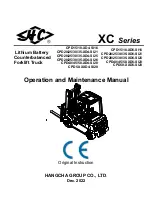
5-6
F-581-R1
ENGINE WITH FUEL SYSTEM
place and should not be touching the top of the injectors
as this can affect their performance. The propane
injectors are a pulse width modulated injector. The
greater the on time, or duty cycle, the more fuel will flow.
The operation of the injectors is based on a diaphragm
instead of a plunger principle. Two conditions are
possible: The injector opens electrically by pulling the
steel core on the diaphragm, by means of a magnetic
field that is generated in the injector coil, during the
opening period. As soon as the magnetic field in the
injector coil drops, by the ECU opening the injector
circuit, the injector closes under the influence of the LPG
pressure across the diaphragm, which is delivered by the
vaporizer.
Figure 5-8: Fuel Rail
Figure 5-9: Fuel Pressure Sensor Location
Heated Oxygen Sensor
The heated oxygen sensor in the exhaust just
downstream of the exhaust manifold measures the
oxygen content of the exhaust and feeds this information
in the form of a voltage to the ECU. A high voltage
(above 0.45) signals a fuel rich exhaust mixture while a
low voltage (under 0.45) indicates a fuel lean mixture.
The ECU uses this information to swing the fuel rich and
lean at 2 to 10 times a second to supply the catalyst with
the optimum mixture for emissions reduction.
The O2 sensor
The O2 sensors used in this engine are “planar” type
sensors and require a small pumping current, supplied by
the ECU, to function correctly. Normally the voltage from
these sensors swings between 0.2 and 0.8 volts.
However, if the pumping current is missing, or the sensor
heater has malfunctioned, or if the sensor circuit is open,
the O2 sensor voltage will rise to above 2.0 volts.
Three-Way Catalytic Converter
The 3-way converter uses a catalyst to convert HC (in the
form of unburned gasoline), CO, and NOx (created when
the heat in the engine forces nitrogen in the air to
combine with oxygen) into harmless compounds. The
converter is often called a three-way catalytic converter
because it helps in reducing these three regulated
emissions. In the converter, the catalyst (in the form of
platinum and palladium) is coated onto a ceramic
honeycomb that is housed in a muffler-like package
attached to the exhaust pipe. The catalyst helps to
convert carbon monoxide into carbon dioxide. It converts
the hydrocarbons into carbon dioxide and water. It also
converts the nitrogen oxides back into nitrogen and
oxygen.
Содержание Bendi B40i4
Страница 2: ......
Страница 26: ...1 20 F 581 R1 INTRODUCTION SAFETY AND INSPECTION...
Страница 100: ...3 52 F 581 R1 TROUBLESHOOTING AND CORRECTIVE MAINTENANCE...
Страница 120: ...4 20 F 581 R1 CALIBRATION AND PROGRAMMING...
Страница 129: ...ENGINE WITH FUEL SYSTEM 5 9 Figure 5 10 Fuel System Troubleshooting...
Страница 133: ...ENGINE WITH FUEL SYSTEM 5 13...
Страница 134: ...5 14 F 581 R1 ENGINE WITH FUEL SYSTEM...
Страница 140: ...6 2 F 581 R1 GM ENGINE SUPPLIER PROVIDED DOCUMENTATION...

































